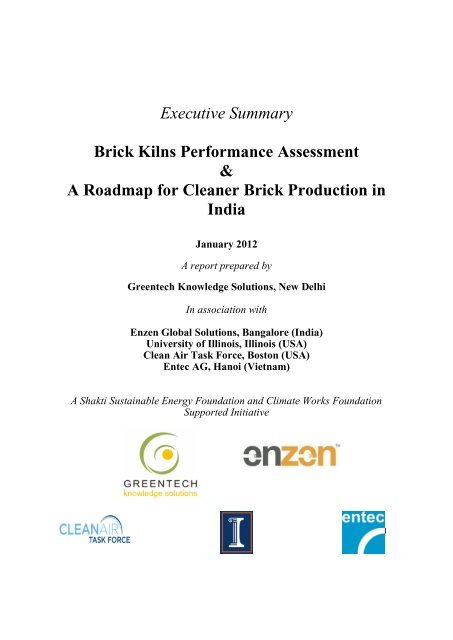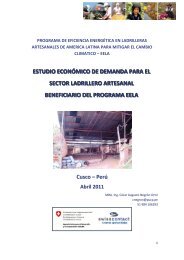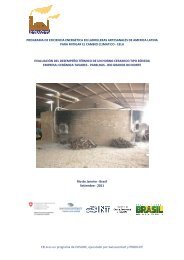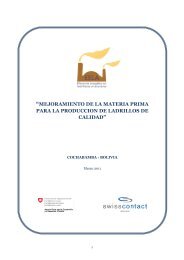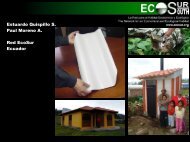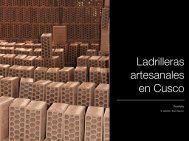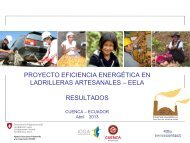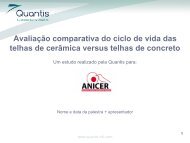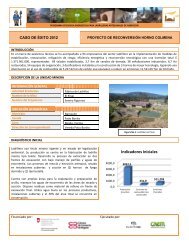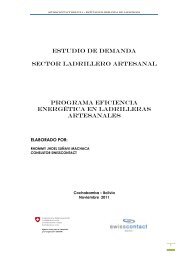A Roadmap for Cleaner Brick Production in India - Red Ladrilleras
A Roadmap for Cleaner Brick Production in India - Red Ladrilleras
A Roadmap for Cleaner Brick Production in India - Red Ladrilleras
- No tags were found...
You also want an ePaper? Increase the reach of your titles
YUMPU automatically turns print PDFs into web optimized ePapers that Google loves.
Project TeamGreentech Knowledge Solutions Pvt. Ltd., New Delhi (<strong>India</strong>)Dr.Sameer Maithel, Mr. Dheeraj Lalchandani, Mr. Gaurav Malhotra, Mr. PrashantBhanwareEnzen Global Solutions Pvt. Ltd., Bangalore (<strong>India</strong>)Dr. R. Uma, Mr. SanthoshRagavan, Mr. Vasudev Athalye, Ms. B<strong>in</strong>diya KR, Mr. Sunil <strong>Red</strong>dyUniversity of Ill<strong>in</strong>ois at Urbana-Champaign, Ill<strong>in</strong>ois (USA)Dr. Tami Bond, Ms. Cheryl WeyantClean Air Task Force, Boston(USA)Ms. Ellen BaumEntec AG, Hanoi (Vietnam)Ms. Vu Thi Kim Thoa, Ms. Nguyen Thu Phuong, Ms. TrÇn Kim ThanhA Shakti Susta<strong>in</strong>able Energy Foundation and Climate Works Foundation supported <strong>in</strong>itiativeDisclaimerThe views expressed <strong>in</strong> this publication are those of the authors/project team and do notnecessarily reflect the views of Shakti Susta<strong>in</strong>able Energy Foundation and ClimateWorksFoundation. Shakti Susta<strong>in</strong>able Energy Foundation and ClimateWorks Foundation do notguarantee the accuracy of the data <strong>in</strong>cluded <strong>in</strong> this publication and does not acceptresponsibility <strong>for</strong> consequence of their use.2
AbstractIntroduction<strong>India</strong> is the second largest producer of clay fired bricks, account<strong>in</strong>g<strong>for</strong> more than 10 percentof global production.<strong>India</strong> is estimated to have more than 100,000 brick kilns, produc<strong>in</strong>gabout 150-200 billion bricks annually, employ<strong>in</strong>g about 10 million workers and consum<strong>in</strong>gabout 25 million tons of coal annually. <strong>India</strong>’s brick sector is characterized bytraditionalfir<strong>in</strong>g technologies; environmental pollution; reliance on manual labour and lowmechanization rate; dom<strong>in</strong>ance of small-scale brick kilns with limited f<strong>in</strong>ancial, technical andmanagerial capacity; dom<strong>in</strong>ance of s<strong>in</strong>gle raw material (clay) and product (solid clay brick);and lack of <strong>in</strong>stitutional capacity <strong>for</strong> the development of the sector.In a first of its k<strong>in</strong>d detailed per<strong>for</strong>mance assessment,the pr<strong>in</strong>cipal <strong>in</strong>vestigat<strong>in</strong>g organizations-Greentech Knowledge Solutions Pvt. Ltd., Enzen Global Solutions Pvt Ltd, and Universityof Ill<strong>in</strong>ois,exam<strong>in</strong>edthe energy, environmental and f<strong>in</strong>ancial per<strong>for</strong>mance and brick maker<strong>in</strong>put <strong>for</strong> five ma<strong>in</strong> brick fir<strong>in</strong>g technologies dur<strong>in</strong>g 2011:Fixed Chimney Bull’s Trench Kiln (FCBTK - <strong>India</strong>)Zig-zag (natural and <strong>for</strong>ced draft - <strong>India</strong>)Vertical Shaft <strong>Brick</strong> Kiln (VSBK – <strong>India</strong> and Vietnam)Down-Draught Kiln (DDK- <strong>India</strong>)Tunnel kiln (Vietnam)The study is one of two research components aimed at develop<strong>in</strong>g strategies <strong>for</strong> the<strong>in</strong>troduction and promotion of cleaner wall<strong>in</strong>g materials <strong>in</strong> <strong>India</strong>.ResultsEnergy per<strong>for</strong>manceA large variation was observed <strong>in</strong> the energy per<strong>for</strong>mance of the monitored kilns. DDK (leastefficient kiln) consumesfourtimes more energy compared to VSBK (most efficient kiln). TheVietnamese VSBK kiln had the lowest thermal energy requirement, followed by the <strong>India</strong>nVSBK, zig-zag kilns and FCBTKs. The tunnel kiln, which <strong>in</strong>corporates a dryer, had higherenergy use.Environmental per<strong>for</strong>manceVSBK had the lowest emissions of Suspended Particulate Matter (SPM) followed by zigzagkiln, tunnel kiln, FCBTK and down-draught kiln. VSBK also had the lowestParticulate Matter (PM 2.5 ) emissions.Of the gaseous pollutants measured,variations <strong>in</strong> the SO 2 concentration were observed,with lowest levels <strong>in</strong> the biomass-fueled DDK. This is because sulphur dioxide (SO 2 ) isdependent on sulphur <strong>in</strong> coal. Oxides of nitrogen (NO x )emissions were generally belowthe detectable levels. The natural draught zig-zag kiln had the lowest carbon monoxide(CO) emissions. CO 2 emissions show similar rank<strong>in</strong>g hierarchy as <strong>for</strong> energy.Both tunnel and VSBK had very low black carbon (BC) emissions, followed by zigzags.FCBTKsand DDK had highest BC emissions.3
F<strong>in</strong>ancial per<strong>for</strong>manceAmong cleaner kiln options, zig-zag kilns require lower <strong>in</strong>vestments and have shorter paybackperiods. Zig-zag kilns offer easy <strong>in</strong>tegration with the exist<strong>in</strong>g production process ofFCBTKs.The tunnel kiln technology is suitable <strong>for</strong> large-scale production, requires largecapital <strong>in</strong>vestment (10-20 times more compared to a zig-zag), and has long pay-back period.VSBK, be<strong>in</strong>g modular <strong>in</strong> nature, can be used <strong>for</strong> small- as well as medium-scale productionbut has problems of low productivity and poor fired brick quality with certa<strong>in</strong> clays. It issuitable <strong>for</strong> fir<strong>in</strong>g only solid bricks and has a longer pay-back period compared to zig-zagkilns.<strong>Production</strong> and sell<strong>in</strong>g price vary significantly by regions of the country; profitability of brickenterprises is higher <strong>in</strong> southern and western <strong>India</strong>.<strong>Brick</strong> sector <strong>in</strong>putMajor issues identified by brick makers that are likely to shape future growth of the brickmak<strong>in</strong>g<strong>in</strong>dustry <strong>in</strong>clude:Shortage of labourIncrease <strong>in</strong> fuel costCompetition from other wall<strong>in</strong>g materialsMultiple barriers to adopt<strong>in</strong>g semi-mechanized technologiesThe way <strong>for</strong>wardThe study recommends that the ef<strong>for</strong>ts to propagate cleaner brick kiln technologies over thenext decade should focus on these specific technical measures:Adoption of cleaner kiln technologies (pr<strong>in</strong>cipally zig-zag and VSBK)Promotion of <strong>in</strong>ternal fuel <strong>in</strong> brick mak<strong>in</strong>g by mechaniz<strong>in</strong>g the brick mak<strong>in</strong>g processPromotion of mechanized coal stok<strong>in</strong>g systemsDiversify<strong>in</strong>g products (e.g. production of hollow and per<strong>for</strong>ated bricks)Promotion of modern renewable energy technologies <strong>in</strong> brick mak<strong>in</strong>gImplementation of these measures can result <strong>in</strong> annual coal sav<strong>in</strong>gs of the order of 2.5 to 5.0million tons/year <strong>in</strong> brick fir<strong>in</strong>g operation and associated CO 2 emission reduction of the orderof 4.5 to 9.0 million tons/year; significant reduction <strong>in</strong> air pollution (<strong>in</strong>clud<strong>in</strong>g SPM, blackcarbon, CO); improvement <strong>in</strong> profitability of brick enterprises; and improvement of work<strong>in</strong>gconditions <strong>for</strong> millions of workers employed <strong>in</strong> brick kilns.Implementation of these measures requires a concerted ef<strong>for</strong>t by Government of <strong>India</strong> andbrick <strong>in</strong>dustry. On the policy and regulatory front, Government of <strong>India</strong> may like to refer tothe policies and regulations framed by some of the other develop<strong>in</strong>g countries <strong>in</strong> Asia.Among these of particular <strong>in</strong>terest are: susta<strong>in</strong>able build<strong>in</strong>g material policy of Vietnam topromote resource-efficient brick production and the recent environment regulation ofBangladesh propos<strong>in</strong>g a time-bound phas<strong>in</strong>g out of FCBTK technology.Next immediate stepsproposed toward achiev<strong>in</strong>g these recommendations <strong>in</strong>clude anenvironmental regulation to phase out older, <strong>in</strong>efficient technologies like FCBTKs, thepredom<strong>in</strong>ant technology <strong>in</strong> use today and <strong>in</strong>troduce newer cleaner brick fir<strong>in</strong>g technologies.;and undertak<strong>in</strong>g an <strong>India</strong>n brick development programme to support f<strong>in</strong>anc<strong>in</strong>g, technologytransfer and skill development activities.4
Executive SummaryI. BackgroundThe growth <strong>in</strong> <strong>India</strong>’s economy and population, coupled with urbanization, has resulted <strong>in</strong> an<strong>in</strong>creas<strong>in</strong>g demand <strong>for</strong> residential, commercial, <strong>in</strong>dustrial, and public build<strong>in</strong>gs as well asother physical <strong>in</strong>frastructure. Build<strong>in</strong>g construction <strong>in</strong> <strong>India</strong> is estimated to grow at a rate of6.6% per year between 2005 and 2030 1 . The build<strong>in</strong>g stock is expected to multiply five timesdur<strong>in</strong>g this period, result<strong>in</strong>g <strong>in</strong> a very large <strong>in</strong>creased demand <strong>for</strong> build<strong>in</strong>g materials.Solid fired clay bricks are one of the most widelyused build<strong>in</strong>g materials <strong>in</strong> the country.<strong>India</strong>is the second largest producer of clay fired bricks, account<strong>in</strong>g<strong>for</strong> more than 10 percent ofglobal production 2 .<strong>India</strong> is estimated to have more than 100,000 brick kilns, produc<strong>in</strong>g about150-200 billion bricks annually 3 .<strong>Brick</strong> mak<strong>in</strong>g <strong>in</strong> <strong>India</strong> is characterised by the follow<strong>in</strong>g features: <strong>Brick</strong> mak<strong>in</strong>g is a small-scale, traditional <strong>in</strong>dustry 4 . Almost all brick kilns are located<strong>in</strong> the rural and peri-urban areas. It is common to f<strong>in</strong>d large brick mak<strong>in</strong>g clusterslocated around the towns and cities, which are the large demand centres <strong>for</strong> bricks.Some of these clusters have up to several hundred kilns. The brick production process is based on manual labour, and brick kilns are estimatedto employ around 10 million workers. <strong>Brick</strong> production is a seasonal vocation, as thebrick kilns do not operate dur<strong>in</strong>g ra<strong>in</strong>y season. Most of the workers migrate with theirfamilies from backward and poor regions of the country. Families, <strong>in</strong>clud<strong>in</strong>g youngchildren, work <strong>in</strong> harsh, low pay<strong>in</strong>g conditions. There is typically a lack of basicfacilities,such as access to clean dr<strong>in</strong>k<strong>in</strong>g water and sanitation. <strong>Brick</strong>sare fired to a temperature of 700 -1100 o C, requir<strong>in</strong>g a large amount of fuel <strong>for</strong>the fir<strong>in</strong>g operation. <strong>Brick</strong> kilns are estimated to consume roughly25 million tonnes ofcoal per year, thus mak<strong>in</strong>g it one of the highest <strong>in</strong>dustrial consumers of coal <strong>in</strong> thecountry. A rapid <strong>in</strong>crease <strong>in</strong> the brick production and the cluster<strong>in</strong>g of brick kilns has givenrise to environmental concerns:o Combustion of coal and other biomass fuels <strong>in</strong> brick kilns results <strong>in</strong> theemissions of particulate matter (PM), <strong>in</strong>clud<strong>in</strong>g black carbon (BC), sulphurdioxide (SO 2 ), oxides of nitrogen (NO x ), and carbon monoxide (CO). Theemission of these pollutants hasan adverse effect on the health of workers and1 McK<strong>in</strong>sey & Company, 2009. Environmental and Energy Susta<strong>in</strong>ability: An Approach <strong>for</strong> <strong>India</strong>. McK<strong>in</strong>sey &Company, Mumbai, <strong>India</strong>.2 Maithel, Sameer, 2003. Energy Utilization <strong>in</strong> <strong>Brick</strong> Kilns. PhD Thesis. Energy Systems Eng<strong>in</strong>eer<strong>in</strong>g, <strong>India</strong>nInstitute of Technology, Bombay3 No agency <strong>in</strong> <strong>India</strong> keeps records of brick production. The numbers referenced here on brick kilns, totalproduction and coal use are estimates that are often quoted by brick <strong>in</strong>dustry associations and experts.4 A traditional <strong>in</strong>dustry is def<strong>in</strong>ed as "an activity, which produces marketable products, us<strong>in</strong>g locally availableraw material and skills and <strong>in</strong>digenous technology."5
vegetation around the kilns. In recent years, higher cost and shortage of goodquality bitum<strong>in</strong>ous coal has resulted <strong>in</strong> <strong>in</strong>creased use of high-ash, high-sulphurcoal, as well as use of <strong>in</strong>dustrial wastes and loose biomass fuels <strong>in</strong> brick kilns.All of these have resulted <strong>in</strong> new air emission challenges.o Use of large quantities of coal <strong>in</strong> brick kilns contributes significantly toemissions of carbon dioxide (CO 2 ).o Good quality agriculture top soil is used <strong>for</strong> brick production. Areas hav<strong>in</strong>glarge concentration of brick kilns suffer from land degradation.Apart from the environmental concerns, the <strong>in</strong>dustry faces other challenges,<strong>in</strong>clud<strong>in</strong>g:o Shortage of workers, result<strong>in</strong>g <strong>in</strong> an <strong>in</strong>crease <strong>in</strong> wages and disruption ofproduction.o Rapid <strong>in</strong>crease <strong>in</strong> the fuel cost and limited availability of good quality coal.o Shortage of good quality clay <strong>in</strong> some regions and an <strong>in</strong>ability of brick makersto adopt technologiesto utilize alternate raw material.o Increased competition from other wall<strong>in</strong>g materials, such as concrete blocks.o New demands result<strong>in</strong>g from trend towards high-rise construction.Despite its significance<strong>in</strong> the construction sector, importance <strong>in</strong> livelihoods of the poor, be<strong>in</strong>ga large coal user and caus<strong>in</strong>g environmental and health impacts, the brick mak<strong>in</strong>g sector hasseen very few development <strong>in</strong>terventions/programmes aimed at improv<strong>in</strong>g the <strong>in</strong>dustry.Initiatives that have been undertaken are listed <strong>in</strong> Table 1. The most significant government<strong>in</strong>terventionswere the environmental regulations enacted <strong>in</strong> the1990’s, which resulted <strong>in</strong>upgradation <strong>in</strong> the fir<strong>in</strong>g technology from mov<strong>in</strong>g chimney bull trench kilns to fixed chimneybull trench kilns.Table 1. Development Programmes/Initiatives <strong>in</strong> the <strong>India</strong>n <strong>Brick</strong> IndustryAgency/ Programme Type of Intervention ImpactTechnical: Introduction ofzig-zag fir<strong>in</strong>g technologyand semi-mechanisationprocessadoption.1970’s Central Build<strong>in</strong>g ResearchInstitute, Government of<strong>India</strong>1990’s Central Pollution ControlBoard/ M<strong>in</strong>istry ofEnvironment and Forest(MoEF)Regulation: Air emissionregulation <strong>for</strong> brick kilns Successful <strong>in</strong> seed<strong>in</strong>gthe technologies. No large-scale Large-scale shift(around 30,000 kilns)from mov<strong>in</strong>g chimneyBull’s Trench Kilntechnology to moreefficient and lesspollut<strong>in</strong>g fixedchimney Bull’s TrenchKiln technology.1995-20042009-ongo<strong>in</strong>gSwiss Agency <strong>for</strong>Development andCooperationUnited NationsDevelopment Program -Global EnvironmentFacility (UNDP-GEF)Technical: Introduction ofVertical Shaft <strong>Brick</strong> Kiln(VSBK) TechnologyTechnical: Introduction ofhollow bricks and otherresource-efficient bricks. Successful <strong>in</strong> seed<strong>in</strong>gthe technology. No large-scaleadoption. Not known6
II.ObjectiveThe objective of the study was to carry out a comprehensive assessment of brick mak<strong>in</strong>gtechnologies to ga<strong>in</strong> a deeper understand<strong>in</strong>g of the energy utilization and emissions fromcurrent technologies as well as technologies that offer the promise of cleaner brickproduction.To address theseobjectives, Greentech Knowledge Solutions Pvt. Ltd (GKS), Enzen GlobalSolutions Pvt Ltd (Enzen) and University of Ill<strong>in</strong>ois (U of I), with Entec AG (Entec), HanoiCenter <strong>for</strong> Environmental and Natural Resources Monitor<strong>in</strong>g and Analysis (CENMA),and theClean Air Task Force (CATF)conducted a detailed monitor<strong>in</strong>g study from February to May2011 exam<strong>in</strong><strong>in</strong>g five brick kiln technologies: two traditional brick kiln technologies widelyprevalent <strong>in</strong> <strong>India</strong> – fixed chimney Bull’s Trench Kiln (BTK) and Down Draught Kiln andthree relatively newer technologies – Vertical Shaft <strong>Brick</strong> Kiln (VSBK), Zig-Zag Kilns, andTunnel Kilns. N<strong>in</strong>e <strong>in</strong>dividual brick kilns were monitored <strong>for</strong> the follow<strong>in</strong>g parameters:Energy per<strong>for</strong>mance: Specific Energy Consumption(SEC)Environment per<strong>for</strong>mance: Emission measurements<strong>for</strong> particulate matter (PM), blackcarbon (BC), and selected gaseous pollutants.F<strong>in</strong>ancial per<strong>for</strong>mance: Capital <strong>in</strong>vestment, cost of production, pay-back period.The study also collected data on the current status of brick <strong>in</strong>dustry <strong>in</strong> the brick mak<strong>in</strong>gclusters visited by the project team.The assessment of the technologies and the <strong>in</strong>dustry were used to makerecommendations <strong>for</strong>strategies promot<strong>in</strong>gcleaner brick production technologies.The results were also used as<strong>in</strong>puts <strong>in</strong> a parallel study 5 undertaken to assess multiple types of wall<strong>in</strong>g materials,<strong>in</strong>clud<strong>in</strong>gclay fired bricks.5 For details please refer to the report “Strategies <strong>for</strong> <strong>Cleaner</strong> Wall<strong>in</strong>g Material <strong>in</strong> <strong>India</strong>” prepared by EnzenGlobal Solutions Pvt Ltd and Greentech Knowledge Solutions Pvt Ltd as a part of the project funded by ShaktiSusta<strong>in</strong>able Energy Foundation <strong>in</strong> November 2011.7
III.MethodologyDetails of the monitored kilns are provided <strong>in</strong> Table 2. Of the n<strong>in</strong>e kilns, seven are located <strong>in</strong><strong>India</strong>, and two – tunnel kiln and a modified VSBK – <strong>in</strong> Vietnam, as neither is <strong>in</strong> operation <strong>in</strong><strong>India</strong>.Both these kilns rely to a large extent on <strong>in</strong>ternal fuel 6 and were expected to have lowerenvironmental footpr<strong>in</strong>t, especially <strong>in</strong> terms of emissions. The selection of <strong>India</strong>n kilns wascarried out to cover major kiln types and fuel comb<strong>in</strong>ations prevalent <strong>in</strong> the country.Table 3 provides the list of technical parameters that were measured. In addition, fuel andclay samples were collected and analyzed from each of the monitored kilns. Bus<strong>in</strong>ess andprocess related <strong>in</strong><strong>for</strong>mation were collected through personal <strong>in</strong>terviews with kiln owners.Location of the monitored kilns is shown <strong>in</strong> Figure 1Figure 1: Location of Monitored Kilns <strong>in</strong> <strong>India</strong> & Vietnam6 The practice of <strong>in</strong>ternal fuel is widely prevalent <strong>in</strong> Ch<strong>in</strong>a – the largest producer of brick <strong>in</strong> the world,account<strong>in</strong>g <strong>for</strong> almost 50% of the production – and Vietnam. In this process, powdered coal is added dur<strong>in</strong>g thebrick <strong>for</strong>m<strong>in</strong>g operation and serves as a fuel dur<strong>in</strong>g fir<strong>in</strong>g.8
Table 2: In<strong>for</strong>mation on Monitored <strong>Brick</strong> KilnsType of kilnNumber ofkilnsmonitoredFeatures of Monitored kilnsPlace Kiln size Fuel usedRemarksFixedChimneyBull’sTrench Kiln(FCBTK)Zig-zagVerticalShaft <strong>Brick</strong>Kiln(VSBK)Down-Draught Kiln(DDK)Tunnel kiln3 Garh Mukteshwar(U.P)LargeCoal (High volatile &high calorific value);rubber tyres; wood logsLudhiana (Punjab) Large Coal (High volatile & high calorific value)Arah (Bihar) Medium Coal (Low volatile and medium calorificvalue)2 Varanasi (NaturalDraft)Varanasi (ForcedDraft)LargeLargeCoal (Two types)Biomass (Sawdust)Coal (Mixture of two types of coal)Mixture of high volatile & high calorificvalue and low volatile & medium calorificvalue2 Arah (Bihar) Small Coal (Two types)o Steam coalo Coal Slurry (Internal)Hung Yenprov<strong>in</strong>ce(Vietnam)MediumCoal (Two types)o Coal powder (Internal)o Coal Slurry (Internal)1 Malur (Karnataka) Small Biomasso Fresh eucalyptus branches1 Nam D<strong>in</strong>hprov<strong>in</strong>ce(Vietnam)LargeCoaloCoal powder‣ Accounts <strong>for</strong> more than 70% of total brick production <strong>in</strong><strong>India</strong>.‣ More than 30,000 FCBTKs currently operational <strong>in</strong> <strong>India</strong>.‣ Emissions from a FCBTK are significantly affected by thefuel used and operat<strong>in</strong>g practice.‣ Improved fir<strong>in</strong>g technology as compared to FCBTK <strong>in</strong>terms of environment emissions & energy consumption.‣ Traditionally uses a fan <strong>for</strong> creat<strong>in</strong>g draft.‣ Recently natural draft (us<strong>in</strong>g a chimney) has beensuccessfully used <strong>in</strong> zig-zag kilns.‣ An estimated 100 VSBKs have been constructed <strong>in</strong> <strong>India</strong>.‣ Considered most efficient kiln technology <strong>in</strong> terms ofenergy use.‣ Improved VSBK technology is extensively used <strong>in</strong> Vietnam‣ More than 300 VSBK enterprises <strong>in</strong> Vietnam.‣ Improved version of a clamp kiln‣ Popular <strong>in</strong> Malur cluster <strong>in</strong> Karnataka‣ Malur cluster has roughly450 DDK .‣ Tunnel kiln is the ma<strong>in</strong> technology <strong>for</strong> fir<strong>in</strong>g bricks <strong>in</strong>developed countries ,as well as several develop<strong>in</strong>gcountries e.g. Ch<strong>in</strong>a, Vietnam‣ <strong>India</strong> does not have a well-function<strong>in</strong>g tunnel kiln <strong>for</strong> claybrick fir<strong>in</strong>g; Vietnam has more than 500 operational tunnelkilnsIX
Table 3: List of Technical MeasurementsProcess variableFuel feed<strong>in</strong>g ratePr<strong>in</strong>ciple of measurementor analysisWeigh<strong>in</strong>g of fuel and timemeasurementSample LocationType*ResponsibleorganizationFuel P GKSPLTemperature of flue gas Thermocouple Stack/ flue duct R GKSPL/ EnzenTemperature of bricks &surfacesK-type Thermocouple/Infrared thermometerInside the kiln/ outsidesurface of kilnPGKSPLStack flow** Pitot tube Stack P EnzenO 2 Electrochemical Stack/flue duct R GKSPL/CENMAInferred from O 2 Stack/ flue duct R GKSPL/CENMACO 2Infrared absorption Diluted exhaust R Uof ICOSO 2NO xSuspended ParticulateMatter (SPM)HFElectrochemical Stack/ flue duct R GKSPL/CENMAElectrochemical Diluted exhaust R Uof IBarium-Thor<strong>in</strong> titrimetricmethodGaseous sampl<strong>in</strong>g followedby colorimetry us<strong>in</strong>gphenoldisulfonic acidStack I Enzen/CENMAStack I EnzenGravimetric Stack IElectric potential methodsus<strong>in</strong>g ion selectivemembrane electrodeEnzenStack R CENMAPM2.5 Gravimetric Diluted exhaust I Uof IElemental and organiccarbonThermal-optical analysis Diluted exhaust I Uof ILight absorption Filter transmittance Diluted exhaust R Uof ILight scatter<strong>in</strong>g Scatter<strong>in</strong>g sensor Diluted exhaust R Uof ISize-resolved carbonparticlesNotes:Cascade impactor plusthermal-optical analysisDiluted exhaust I Uof I* Average of s<strong>in</strong>gle-po<strong>in</strong>t observations (P); Integrated sample (I) taken over many m<strong>in</strong>utes; Real-timeobservations (R) averaged <strong>for</strong> presentation.CENMA: Hanoi Centre <strong>for</strong> Environmental and Natural Resources Monitor<strong>in</strong>g and Analysis, Vietnam.GKSPL: Greentech Knowledge Solutions Pvt. Ltd. U of I: University of Ill<strong>in</strong>ois.** For duct diameter smaller than 0.30 m, standard or modified hemispherical-nosed pitot tube wasused, with a m<strong>in</strong>imum diameter of 0.1 m. For low velocity (less than 3m/s) differential manometer wasused.10
IV.Energy & Environment Per<strong>for</strong>manceEnergy Per<strong>for</strong>manceThe Specific Energy Consumption (SEC) is the amount of thermal energy required to fire 1kg of brick. Lower SEC signifies efficient operation of the kiln. The SEC <strong>for</strong> the monitoredkilns are presented <strong>in</strong> Table 4.The improved VSBK kiln fromVietnam had the lowest SECrequirement at 0.54 MJ/kg of fired brick, followed by thezig-zag kilns (1.12 MJ/kg of firedbrick) and FCBTKs (1.22 MJ/kg of fired brick). The tunnel kiln, which <strong>in</strong>corporates adryer,had higher SEC of 1.47 MJ/kg of fired brick.The DDKhad the highest SEC (2.9 MJ/kgof fired brick), and it consumed 4-5 times more energy compared to a VSBK.Table 4: SEC of the Monitored KilnsFir<strong>in</strong>g TechnologyProcessSEC-Thermal energy(MJ/kg fired brick)*Electricity/ mechanical powerused <strong>in</strong> theproduction process **FCBTKManualmould<strong>in</strong>g&sun-dry<strong>in</strong>g1.22NoneZig-zagManualmould<strong>in</strong>g&sun-dry<strong>in</strong>g1.12None <strong>in</strong> case of natural draught36 lt diesel/day (SEC: 0.015 MJ ofprimary energy/kg of fired brickprimary energy) <strong>for</strong> operat<strong>in</strong>g the fan <strong>in</strong>the <strong>for</strong>ced draught kilnVSBK<strong>India</strong>n VSBK:Manualmould<strong>in</strong>g&sun-dry<strong>in</strong>gVietnam: Extrudermould<strong>in</strong>g& shadedry<strong>in</strong>g0.950.54 <strong>India</strong>n VSBK: 10 lt diesel/day (SEC:0.03 MJ of primary energy/kg of firedbrick ) <strong>for</strong> operat<strong>in</strong>g the conveyor (<strong>for</strong>1-shaft operation). Vietnamese VSBK: 15 kWh/1000bricks (SEC: 0.1 MJ of primaryenergy/kg of fired brick) <strong>for</strong> operat<strong>in</strong>gthe extruder, lift<strong>in</strong>g of bricks, operationof unload<strong>in</strong>g mechanism.Down draftManual mould<strong>in</strong>g&shade dry<strong>in</strong>g2.9NoneTunnel– Vietnam –Internal FuelExtruder mould<strong>in</strong>g,dry<strong>in</strong>g <strong>in</strong> shade and<strong>in</strong> a tunnel dryer.1.47 ***40 kWh/1000 bricks (SEC: 0.3 MJ ofprimary energy/kg of fired brick) <strong>for</strong>operat<strong>in</strong>g the extruder, tunnel dryer,tunnel kiln , etc.Notes:*The SEC values <strong>for</strong> FCBTK and zig-zag are simple average of the three FCBTKs and two zig-zag kilnsrespectively; <strong>for</strong> all the other kiln types, the data is <strong>for</strong> a s<strong>in</strong>gle kiln.**Energy/fuel used <strong>for</strong> produc<strong>in</strong>g heat <strong>for</strong> fir<strong>in</strong>g and dry<strong>in</strong>g process.*** The kiln and the dryer are <strong>in</strong>terconnected. The SEC also <strong>in</strong>cludes the energy required <strong>in</strong> the tunnel dryer.11
Environment Per<strong>for</strong>manceThe environmental per<strong>for</strong>mance results are presented below.Suspended Particulate MatterSuspended Particulate Matter (SPM)is a term used <strong>for</strong> airborne particles ofdiameter less than100 µm. The emission factor <strong>in</strong> terms of g/kg of fired brick <strong>for</strong> SPM is presented <strong>in</strong> Table 5.VSBK had the lowest SPM emission factor,followed by zig-zag kiln, tunnel kiln, FCBTK andDDK, respectively. Due to the addition of powdered fuel with the clay and steady-statecombustion conditions, VSBK and tunnel kilnswere among the lowest emitters of SPM.Better combustion conditions resulted <strong>in</strong> lower SPM <strong>in</strong> properly operated zig-zag kilnscompared to FCBTKParticulate Matter (PM 2.5 )Emission norms <strong>in</strong> <strong>India</strong> do not address PM 2.5 specifically, but it is frequently monitoredbecause of its environmental and health effects. F<strong>in</strong>e particulate matter (diameters less than2.5 µm) can penetrate more deeply <strong>in</strong>to lungs than larger particles. It also has a longeratmospheric lifetime and a disproportionately greater effect on visibility and climate,relativeto larger particles. VSBK technology had the lowest PM 2.5 emissions, and DDKhad thehighest PM 2.5 emissions.Gaseous PollutantsKilns were monitored <strong>for</strong> sulphur dioxide (SO 2 ), oxides of nitrogen (NO x) carbon monoxide(CO) emissions and carbon dioxide (CO 2 ). Table 5 provides the emission factors <strong>for</strong> variouspollutants monitored <strong>in</strong> the study, normalized to grams of pollutant/kg of fired brick.SO 2 emissions stem from the sulphur content of fuel,there<strong>for</strong>e significant variation <strong>in</strong> theSO 2 concentration were observed <strong>in</strong> the monitored kilns. SO 2 concentration was lowest <strong>in</strong>down draft kiln,which uses biomass fuel,with negligible sulphur content.NO x emissions were generally very low and below the detectable levels.Emissions of carbon monoxide (CO) are an <strong>in</strong>dication of <strong>in</strong>complete combustion of fuel. Zigzagkilns hadthe lowest CO emissions. With<strong>in</strong> the zig-zag technology, the monitored naturaldraught zig-zag kiln had much lower CO emissions as compared to the monitored <strong>for</strong>ceddraught zig-zag kiln. Good fuel-feed<strong>in</strong>g and operat<strong>in</strong>g practices support this improvement.CO 2 emissions are directly related to the SEC and carbon content of fuels be<strong>in</strong>g used <strong>in</strong> thekiln. Hence the CO 2 emissions show similar rank<strong>in</strong>g hierarchy as <strong>for</strong> SEC.12
Table 5: Emission Factors <strong>for</strong> the Monitored KilnsTechnologySPMEmission Factors (g/kg of fired brick)PM2.5 SO 2 CO CO 2FCBTK 0.86 0.18 0.66 2.25 115Zig-zag 0.26 0.13 0.32 1.47 103Notes:VSBK 0.11 0.09 0.54 1.84 70DDK 1.56 0.97 n.d 5.78 282Tunnel 0.31 0.18 0.72 2.45 166The emission factors <strong>for</strong> FCBTK, zig-zag are VSBK are simple average of the three FCBTKs,two zig-zag kilns and two VSBK kilns respectively; <strong>for</strong> all the other kiln types, the data is <strong>for</strong>a s<strong>in</strong>gle kiln.n.d. = not detectable (measurement below detection limitBlack and Organic CarbonBlack carbon (BC) is a combustion product predom<strong>in</strong>antly composed of strongly bondedgraphitic-like carbon r<strong>in</strong>gs. This composition causes black carbon to be thermally stable athigh temperatures and to strongly absorb visible light, caus<strong>in</strong>g warm<strong>in</strong>g. Organic carbon(OC) comprises all carbon species that are neither black nor carbonate carbon.This study represents the first-ever measurements of BC from brick kilns, despite the fact thatbrick kiln upgrades have been targeted as a strategy to reduce BC. In November 2011, theUnited Nations Environmental Program <strong>in</strong> their assessment, Near-term Climate Protectionand Clean Air Benefits:Actions <strong>for</strong> Controll<strong>in</strong>g Short-Lived Climate Forcers,proposedreplac<strong>in</strong>g traditional brick kilns with more efficient ones, particularly VSBKs, as a measureto reduce BC.Two methods were used <strong>in</strong> this study to measure light-absorb<strong>in</strong>g carbon.1. Thermo-optical analysis measured “elemental carbon” which is stable at hightemperatures and is considereda synonym to BC. This analysis also measured OC.2. Particle light absorption measured <strong>in</strong> units of square meters (m 2 ),together withscatter<strong>in</strong>g measurements, can be used to calculate affect of particles on visibilityand radiative transfer. The s<strong>in</strong>gle scatter<strong>in</strong>g albedo 7 is a measure of particlelightness, with pure BC hav<strong>in</strong>g a value of about 0.22, polluted urban air about 0.7,and pure white particles 1.07 S<strong>in</strong>gle scatter<strong>in</strong>g albedo – the ratio of scatter<strong>in</strong>g efficiency to total ext<strong>in</strong>ction efficiency (which is also termed"attenuance", a sum of scatter<strong>in</strong>g and absorption). Most often it is def<strong>in</strong>ed <strong>for</strong> small-particle scatter<strong>in</strong>g ofelectromagnetic waves. A s<strong>in</strong>gle scatter<strong>in</strong>g albedo of unity implies that all particle ext<strong>in</strong>ction is due toscatter<strong>in</strong>g; conversely, a s<strong>in</strong>gle scatter<strong>in</strong>g albedo of zero implies that all ext<strong>in</strong>ction is due to absorption.(http://en.wikipedia.org/wiki/S<strong>in</strong>gle_scatter<strong>in</strong>g_albedo)13
Results of elemental and organic carbon measurements; absorption and s<strong>in</strong>gle scatter<strong>in</strong>galbedo, are shown <strong>in</strong> Table 6.Table 6: Results of Thermo-optical and Light Absorption/Scatter<strong>in</strong>g measurementsTechnologyElemental Carbon(g/kg fired brick)Organic Carbon(g/kg fired brick)Absorption (m 2 /kgfired brick) *S<strong>in</strong>gle Scatter<strong>in</strong>gAlbedo *FCBTK 0.13 0.01 0.22 0.67Zig-zag 0.04 0.02 0.16 0.64 **VSBK 0.002 0.06 0.06 0.77DDK 0.29 0.09 1.13 3.5Tunnel n.d. n.d. n.d. 0.13Notes:The results <strong>for</strong> FCBTK, zig-zag are VSBK are simple average of the three FCBTKs, two zig-zag kilns andtwo VSBK kilns respectively; <strong>for</strong> all the other kiln types, the data is <strong>for</strong> a s<strong>in</strong>gle kiln..n.d. = not detectable (measurement below detection limit)*At red wavelength (660 nm)** Excludes natural draught zig-zag kiln, where scatter<strong>in</strong>g measurements were spurious and may beaffected by measurement error, as the read<strong>in</strong>gs are much higher than expected <strong>for</strong> the measured levels ofparticulate matter.Both tunnel and VSBK had very low BC emissions, as <strong>in</strong>dicated by low value of elementalcarbon and high values <strong>for</strong> s<strong>in</strong>gle scatter<strong>in</strong>g albedo. In the tunnel kiln, the BC emissions werebelow the detection level. The low BC emissions<strong>in</strong> the tunnel and the VSBK can be attributedto the steady-state combustion conditions <strong>in</strong> these kilns and use of <strong>in</strong>ternal fuel.FCBTKsandDDKhad highest BC emissions. In both of these kilns, fuel feed<strong>in</strong>g is <strong>in</strong>termittent, andcombustion conditions show large variation with time. The results show that large BCemissions take place around fuel feed<strong>in</strong>g <strong>in</strong>tervals.Improved combustion conditions <strong>in</strong> zigzagkilns, <strong>in</strong> the <strong>for</strong>m of cont<strong>in</strong>uous feed<strong>in</strong>g of fuel <strong>in</strong> small quantities and better mix<strong>in</strong>g offuel and air,lowered BC emissions compared to FCBTKs.The BC emission factors of brick kilnsmay also be compared with other BC emitt<strong>in</strong>g sources.Figure2compares BC emission factors from this study, with emissions from other types ofcoal combustion and from mobile sources.Emissions from coal combustion can vary widely depend<strong>in</strong>g on the quality of thecombustion. The figure shows that well-operat<strong>in</strong>g power plants, with emission controls, havevery low emissions BC, <strong>in</strong>dustrial stoker boilers have detectable emissions, and heat<strong>in</strong>gstoves – which have no control of emissions or airflow with<strong>in</strong> the stove – have quite highemissions. (Heat<strong>in</strong>g stoves are not used <strong>in</strong> <strong>India</strong>.) The difference <strong>in</strong> emissions is not causedby the fuel, but rather is attributable to the management of the fuel-air mix<strong>in</strong>g and properhandl<strong>in</strong>g of the exhaust products. Emissions of the kilns measured <strong>in</strong> this project fall between14
those of <strong>in</strong>dustrial boilers and heat<strong>in</strong>g stoves, as could be expected based on the combustionmanagement.g BC/MJ fuel0 0.05 0.1 0.15 0.2 0.25 0.3FCBTKZigzagVSBKDown draughtTunnelPower plantKilnsOther coalMobile sourcesIndustrial boilerHeat<strong>in</strong>g stoveDiesel truckGasol<strong>in</strong>e vehicleFigure 2: Comparison of BC Emitted from Kilns <strong>in</strong> this Study to Other Coal Sourcesand Mobile Sources 8 .V. F<strong>in</strong>ancial Per<strong>for</strong>mance & Quality of Fired <strong>Brick</strong>sCapital CostA comparison of the f<strong>in</strong>ancial per<strong>for</strong>mance of various technologies is presented <strong>in</strong> Table7.FCBTK and zig-zag kilns require lower <strong>in</strong>vestments and have shorter pay-back periods.The tunnel kiln technology is suitable <strong>for</strong> large-scale production and requires large capital<strong>in</strong>vestment (10-20 times compared to other kiln types). VSBK, be<strong>in</strong>g modular <strong>in</strong> nature, canbe used <strong>for</strong> small- as well as medium-scale production. It has a longer pay-back periodcompared to FCBTK and zig-zag kilns.8Values presented <strong>for</strong> mobile sources are approximate emission rates <strong>for</strong> unregulated vehicles.15
Table 7: Comparison of Kiln Technologies (F<strong>in</strong>ancial Per<strong>for</strong>mance)TechnologyFCBTKFeaturesChimney height 27 to 30 m; kilncircuit capacity 0.5 to 1 millionbricks.Approx.Capital Cost*(US $)40,000 -60,000Typical<strong>Production</strong>simple paybackperiodCapacity(millionunder <strong>India</strong>nbricks/year)conditions4-8 3 yearsshed, extruder <strong>for</strong> fir<strong>in</strong>g bricksNote: * exclud<strong>in</strong>g the cost of land; simple pay-back assum<strong>in</strong>g 100% capacity utilization<strong>Production</strong> Costand Sell<strong>in</strong>g PriceData was collected on production cost and revenue. Typical production and sell<strong>in</strong>g price ofbricks <strong>for</strong> different regions <strong>in</strong> the country are shown <strong>in</strong> Table 8. The profitability of brickenterprises is higher <strong>in</strong> southern and western <strong>India</strong>, due to higher sell<strong>in</strong>g price of bricks.16
Table 8: Typical <strong>Production</strong> and Sell<strong>in</strong>g Price DataIndo Gangetic Pla<strong>in</strong>s (Punjab,Haryana, UP, Bihar)Southern and western <strong>India</strong><strong>Production</strong> cost: Rs 2.00- 2.50 /brick<strong>Production</strong> cost: Rs 2.50 -3.50/brickSell<strong>in</strong>g Price: Rs 3.00 – 4.00/ brickSell<strong>in</strong>g Price: Rs 4.50 – 8.00/ brickFigure 3 shows the typical break-up of production cost <strong>for</strong> a FCBTK <strong>in</strong> Indo-Gangetic pla<strong>in</strong>sand illustrates that fuel is the largest cost component followed by operations (ma<strong>in</strong>lymanpower) cost. The production cost of natural draught zig-zag kiln is 15% lower than thatof FCBTK.Adm<strong>in</strong>istration& legal6%Losses6%Raw Material15%Fuel45%Operation28%Total <strong>Production</strong> Cost:- Rs. 2.35/<strong>Brick</strong>Figure 3: Average <strong>Production</strong> Cost Break-up Data <strong>for</strong> Monitored FCBTKs <strong>in</strong> Indo-Gangetic RegionQuality of Fired <strong>Brick</strong>sThe quality of fired brick depends both on the quality of green bricks as well as on the fir<strong>in</strong>gprocess.The tunnel kiln is ranked best <strong>in</strong> terms of fired brick quality. Factors contribut<strong>in</strong>g to thisimproved quality <strong>in</strong>clude:1. F<strong>in</strong>e control over the dry<strong>in</strong>g and fir<strong>in</strong>g process2. The ability to achieve uni<strong>for</strong>m temperature distribution <strong>in</strong> the fir<strong>in</strong>g zone,3. Due to their large production capacity,they have mechanized brick production.Both the VSBKs had problems with brick quality, and the quality was lower <strong>in</strong> the <strong>India</strong>nVSBK. This is due to a variety of factors:17
1. High static and dynamic load on the lower brick stack<strong>in</strong>g <strong>in</strong> the shaft results <strong>in</strong>damage to the bricks.2. Fast heat<strong>in</strong>g up and cool<strong>in</strong>g down of bricks <strong>in</strong> the kiln can cause fir<strong>in</strong>g andcool<strong>in</strong>g cracks <strong>in</strong> the bricks.3. Some damage is also caused from excessive handl<strong>in</strong>g of bricks dur<strong>in</strong>g lift-up tothe kiln top and <strong>in</strong> the load<strong>in</strong>g processDue to the lower density and lower compressive strength of hand-moulded bricks, theproblem <strong>in</strong> brick quality are more pronounced when hand-moulded bricks are fired <strong>in</strong>VSBK. From the experience of Vietnam, it was evident that the fir<strong>in</strong>g of mach<strong>in</strong>emouldedbricks results <strong>in</strong> improvement <strong>in</strong> quality.The FCBTK and zig-zag have slow heat<strong>in</strong>g and cool<strong>in</strong>g rates and generally do not haveproblem of <strong>for</strong>mation of fir<strong>in</strong>g and cool<strong>in</strong>g cracks. The FCBTK does not have uni<strong>for</strong>mtemperature distribution <strong>in</strong> the fir<strong>in</strong>g zone and hence only 60-70% bricks are properly fired;the rema<strong>in</strong><strong>in</strong>g production is either under- or over-fired. The zig-zag has more uni<strong>for</strong>mtemperature distribution, and hence 80-90% of the bricks are properly fired.VI.<strong>Brick</strong> Sector ScenarioInput from prom<strong>in</strong>ent brick makers was sought via <strong>in</strong>terviews dur<strong>in</strong>g monitor<strong>in</strong>g and twostakeholder workshops.The ma<strong>in</strong> objective of these <strong>in</strong>terviews/<strong>in</strong>teractions was to get betterunderstand<strong>in</strong>g of the current status of brick mak<strong>in</strong>g and future trends.Ma<strong>in</strong> f<strong>in</strong>d<strong>in</strong>gs are as follows:Shortage of workers:The brick <strong>in</strong>dustry is fac<strong>in</strong>g a severe worker shortage, which resulted <strong>in</strong>a decrease <strong>in</strong> brick production of upto 30% <strong>in</strong> several important brick mak<strong>in</strong>g clusters dur<strong>in</strong>g2011. The worker shortage was first noticed <strong>in</strong> 2007 with the first implementation phase ofthMahatma Gandhi National Rural Employment Guarantee Act 9 . Most of the brick kilnowners want to reduce dependency on workers through semi-mechanisation 10 of theproduction process.Rapid <strong>in</strong>crease <strong>in</strong> the fuel cost: Fuel prices have risen 100-175% over the past five years.Management of fuel cost is an important consideration <strong>for</strong> brick makers, result<strong>in</strong>g <strong>in</strong> shifts tocheaper fuels. The majority of the brick makers do not have practical knowledge and skills toadopt energy conservation measures. There are no <strong>in</strong>termediaries to help brick makersimplement energy conservation measures.9 The Mahatma Gandhi National Rural Employment Guarantee Act (MNREGA) aims at enhanc<strong>in</strong>g thelivelihood and security of people <strong>in</strong> rural areas by guarantee<strong>in</strong>g hundred days of wage-employment <strong>in</strong> af<strong>in</strong>ancial year to a rural household whose adult members volunteer to do unskilled manual work.10 Here semi-mechanization means use of mach<strong>in</strong>ery <strong>for</strong> mould<strong>in</strong>g bricks us<strong>in</strong>g an extruder or a soft-mudmould<strong>in</strong>g mach<strong>in</strong>e and partial mechanization of the material handl<strong>in</strong>g.18
Competition from other wall<strong>in</strong>g materials: Clay brick makers are fac<strong>in</strong>g competition fromother wall<strong>in</strong>g materials. This is particularly true <strong>in</strong>southern and western <strong>India</strong>.Barriers <strong>in</strong> adoption of new technologies <strong>for</strong> semi-mechanization• The majority (>90%) of brick kilns <strong>in</strong> the Indo-Gangetic pla<strong>in</strong>s are located on leasedland. This is expected to be a large barrier <strong>in</strong> mak<strong>in</strong>g <strong>in</strong>vestments <strong>in</strong> construction ofnew facilities andmach<strong>in</strong>ery. A shift to new technologies would require<strong>in</strong>vestment <strong>in</strong>land or renegotiat<strong>in</strong>g lease agreements. Due to high price of land around cities, brickenterprises are likely to relocate further away from towns and cities.• Limited or no access to grid-electricity: Semi-mechanization of the brick productionprocess requires electricity. Most of the exist<strong>in</strong>g brick kilns either do not have accessto grid electricity or are located on rural electricity feeders, which are prone to poweroutages and poor power quality. This is a significant barrier <strong>in</strong> adopt<strong>in</strong>g newtechnologies. Adopt<strong>in</strong>g new technologies requires <strong>in</strong>vestments<strong>in</strong> captive powergeneration facilities by brick makers.• Low profit marg<strong>in</strong>s <strong>for</strong> mach<strong>in</strong>e--moulded bricks: Mach<strong>in</strong>e-moulded bricks have ahigher production cost and face stiff competition from lower-priced manuallyproduced bricks.• F<strong>in</strong>anc<strong>in</strong>g: The capital <strong>in</strong>vestment <strong>in</strong> any robust and reliable semi-mechanizationbrick mak<strong>in</strong>g package ranges from Rs 10-200 million. The majority of brick makershave no or limited access to bank credit.• Lack of availability of off-the-shelf technology packagesand technologyproviders:Standard technology packages are not available. The know-how of the zigzagfir<strong>in</strong>g is limited to a handful of brick makers. For VSBK technology there is onlyone active technology provider. The manufactur<strong>in</strong>g of mach<strong>in</strong>ery <strong>for</strong> brick mak<strong>in</strong>g isconcentrated <strong>in</strong> a few small-scale enterprises. Recently some European brick-mak<strong>in</strong>gmach<strong>in</strong>ery manufacturers have entered the market and are <strong>in</strong>volved <strong>in</strong> field trials on<strong>India</strong> specific technology packages.• Lack of availability of tra<strong>in</strong>ed manpower:Operation of any new technology requirestra<strong>in</strong>ed manpower, which is <strong>in</strong> short supply. The VSBK monitored dur<strong>in</strong>g the studywas operat<strong>in</strong>g at 50% of its rated capacity, ma<strong>in</strong>ly because of a workershortage.Similarly, the poor operation of the zig-zag <strong>for</strong>ced draft kiln can be attributed toabsence of tra<strong>in</strong>ed manpower <strong>for</strong> its operation. Currently, there is no system <strong>in</strong> placeto tra<strong>in</strong> manpower <strong>for</strong> the brick <strong>in</strong>dustry.VII.A Road Map <strong>for</strong> <strong>Cleaner</strong> <strong>Brick</strong> <strong>Production</strong> <strong>in</strong> <strong>India</strong><strong>India</strong>’s brick sector is characterized by traditionalfir<strong>in</strong>g technologies, with high emissions;reliance on manual labour and low mechanization rate; dom<strong>in</strong>ance of small-scale brick kilnswith limited f<strong>in</strong>ancial, technical and managerial capacity; and dom<strong>in</strong>ance of s<strong>in</strong>gle rawmaterial (clay) and product (solid clay brick).This report suggests that development of a cleaner brick production <strong>in</strong>dustry <strong>in</strong> <strong>India</strong> over thenext tenyearsshould aim at:19
Adoption of cleaner kiln technologies: The FCBTKs and DDKs should be replaced withzigzag,VSBK or other cleaner kiln technologiesby 2020.Zig-zag kilns appear to be the logical replacement <strong>for</strong> FCBTKs, because of low capital<strong>in</strong>vestment, easy <strong>in</strong>tegration with the exist<strong>in</strong>g production process, and possibility ofretrofitt<strong>in</strong>g FCBTKs <strong>in</strong>to zig-zagfir<strong>in</strong>g. The zig-zag kiln per<strong>for</strong>mance strongly dependson the kiln operation practices;also,zig-zag natural draught kiln appear to per<strong>for</strong>mbetter than zig-zag <strong>for</strong>ced draught kiln. These aspects need further study be<strong>for</strong>ef<strong>in</strong>aliz<strong>in</strong>g recommendations and <strong>for</strong>mulat<strong>in</strong>g a large-scale dissem<strong>in</strong>ation programme<strong>for</strong> zig-zag kilns.VSBK appears to have a limited market, ma<strong>in</strong>ly because of its <strong>in</strong>ability to producegood quality bricks from all types of clays and low productivity under the <strong>India</strong>nconditions. Incorporation of features of Vietnamese VSBKs <strong>in</strong>to <strong>India</strong>n VSBKs mayhelp <strong>in</strong> improv<strong>in</strong>g the VSBK technology package. VSBK dissem<strong>in</strong>ation needs to beproperly targeted.The tunnel kiln technology is capital <strong>in</strong>tensive, and the current technological knowhowand experience is limited <strong>in</strong> <strong>India</strong>. Adoption of tunnel kiln also requires extensivemodifications <strong>in</strong> brick mould<strong>in</strong>g, dry<strong>in</strong>g andmaterial handl<strong>in</strong>g. Widespread adoption oftunnel kiln technology is not <strong>for</strong>eseen <strong>in</strong> immediate future.Promotion of <strong>in</strong>ternal fuel <strong>in</strong> brick mak<strong>in</strong>g by mechaniz<strong>in</strong>g the brick mak<strong>in</strong>g process;Internal fuel addition significantly reduces SPM and BCemissions. Cheaper fuels, such as,coal slurry, coal dust, charcoal dust, and sawdustcan be used as <strong>in</strong>ternal fuels and canhelpreduce fuel cost. Management of <strong>in</strong>ternal fuel addition is extremely difficult <strong>in</strong> the manualmold<strong>in</strong>g process. Semi-mechanization of mould<strong>in</strong>gneeds to be promoted to support use of<strong>in</strong>ternal fuels. Semi-mechanization of the brick mould<strong>in</strong>g process would have other benefits,<strong>in</strong>clud<strong>in</strong>g an ability to use <strong>in</strong>ferior clay resources and wastes, reduction <strong>in</strong> drudgery and betterwork<strong>in</strong>g conditions <strong>for</strong> workers, and potential to produce hollow and per<strong>for</strong>ated bricks.Promotion of mechanized coal stok<strong>in</strong>g systems:High PM and BC emissions <strong>in</strong> FCBTKsoccur dur<strong>in</strong>g the period of fuel feed<strong>in</strong>g. Cont<strong>in</strong>uous feed<strong>in</strong>g of properly sized fuel, us<strong>in</strong>g acoal stoker <strong>in</strong> a FCBTK or a zig-zag kiln, can reduce the emissions significantly.Diversify<strong>in</strong>g products (e.g. hollow and per<strong>for</strong>ated bricks):Hollow and per<strong>for</strong>ated bricksrequire less clay and fuel as well as provide better thermal <strong>in</strong>sulation of walls and henceneeds to be promoted.Promotion of modern renewable energy technologies <strong>in</strong> brick mak<strong>in</strong>g:Apart from the CO 2emissions caused by fir<strong>in</strong>g of coal <strong>in</strong> brick kilns, the current brick mak<strong>in</strong>g practice has a verylow carbon footpr<strong>in</strong>t. Any mechanization of the brick mak<strong>in</strong>g process, as proposed above,would require use of electricity.Captive power generation us<strong>in</strong>g diesel fuel is expensive andhas a high carbon footpr<strong>in</strong>t. Renewable electricity generation options us<strong>in</strong>g biomass gasifiersand solar PV need to be promoted. Semi-mechanization of the brick mould<strong>in</strong>g process alsorequires artificial dry<strong>in</strong>g, which may <strong>in</strong>crease the coal consumption <strong>in</strong> brick mak<strong>in</strong>g. There is20
a need to develop more efficient dry<strong>in</strong>g systems based on use of modern solar thermal andbiomass energy technologies.To achieve these goals, recommendations to Government of <strong>India</strong>,<strong>in</strong>clude:Modification <strong>in</strong> environmentalregulationsto phase-out FCBTKs:Environmental regulationscan be amended to phase-out FCBTKsand replacethem withcleaner brick fir<strong>in</strong>g technologies. Any action on environmental regulations needs to besupported by complementary support<strong>in</strong>g actions, which may <strong>in</strong>clude:Preparation of standard zig-zagand other cleaner kiln technology knowledge packages(conta<strong>in</strong><strong>in</strong>g design, construction and operation guidel<strong>in</strong>es).Tra<strong>in</strong><strong>in</strong>g and certify<strong>in</strong>g a cadre of technology providers <strong>in</strong> cleaner brick fir<strong>in</strong>gtechnologies.Educat<strong>in</strong>g/tra<strong>in</strong><strong>in</strong>g brick kiln owners, supervisors and workers <strong>in</strong> cleaner brick fir<strong>in</strong>gtechnologiesSupport<strong>in</strong>g a modest R&D programme to consider improvements <strong>in</strong> zig-zag fir<strong>in</strong>gpackage, e.g. mechanical stok<strong>in</strong>g of fuel; replacement of ash layer on the top of thekiln.Conduct<strong>in</strong>g environment monitor<strong>in</strong>g of kilns to ga<strong>in</strong> further understand<strong>in</strong>g and guidethe policy action.Launch<strong>in</strong>g an <strong>India</strong>n brick development programmeThere is a strong case <strong>for</strong> a national programme <strong>for</strong> the development of the brick sector.Theprogramme should address issues related to: Planned relocation of brick <strong>in</strong>dustry clusters: Identify sites <strong>for</strong> relocation of brick<strong>in</strong>dustry, based on factors such as clay resource mapp<strong>in</strong>g, mapp<strong>in</strong>g of waste sourcesappropriate<strong>for</strong> brick mak<strong>in</strong>g, access to electricity and distance from demand centers. Technology transfer and dissem<strong>in</strong>ation: Support <strong>for</strong> technologytransfer/demonstration/field test<strong>in</strong>g of semi-mechanized and cleaner fir<strong>in</strong>g technologypackages. Skill development: Develop a cadre of local technology providers, who can alsoprovide service and tra<strong>in</strong> supervisors and the work<strong>for</strong>ce.F<strong>in</strong>anc<strong>in</strong>g: Provide access to f<strong>in</strong>anc<strong>in</strong>g.Advocate <strong>for</strong> policy change. Work with appropriate partners to enact environmentalpolicies to trans<strong>for</strong>m the <strong>in</strong>dustry.Implementation of these measures can result <strong>in</strong> annual coal sav<strong>in</strong>gs of the order of 2.5 to 5.0million tons/year; significant reduction <strong>in</strong> air pollution; improvement <strong>in</strong> profitability of brickenterprises; and improvement of work<strong>in</strong>g conditions <strong>for</strong> millions of workers employed <strong>in</strong>brick kilns.21


